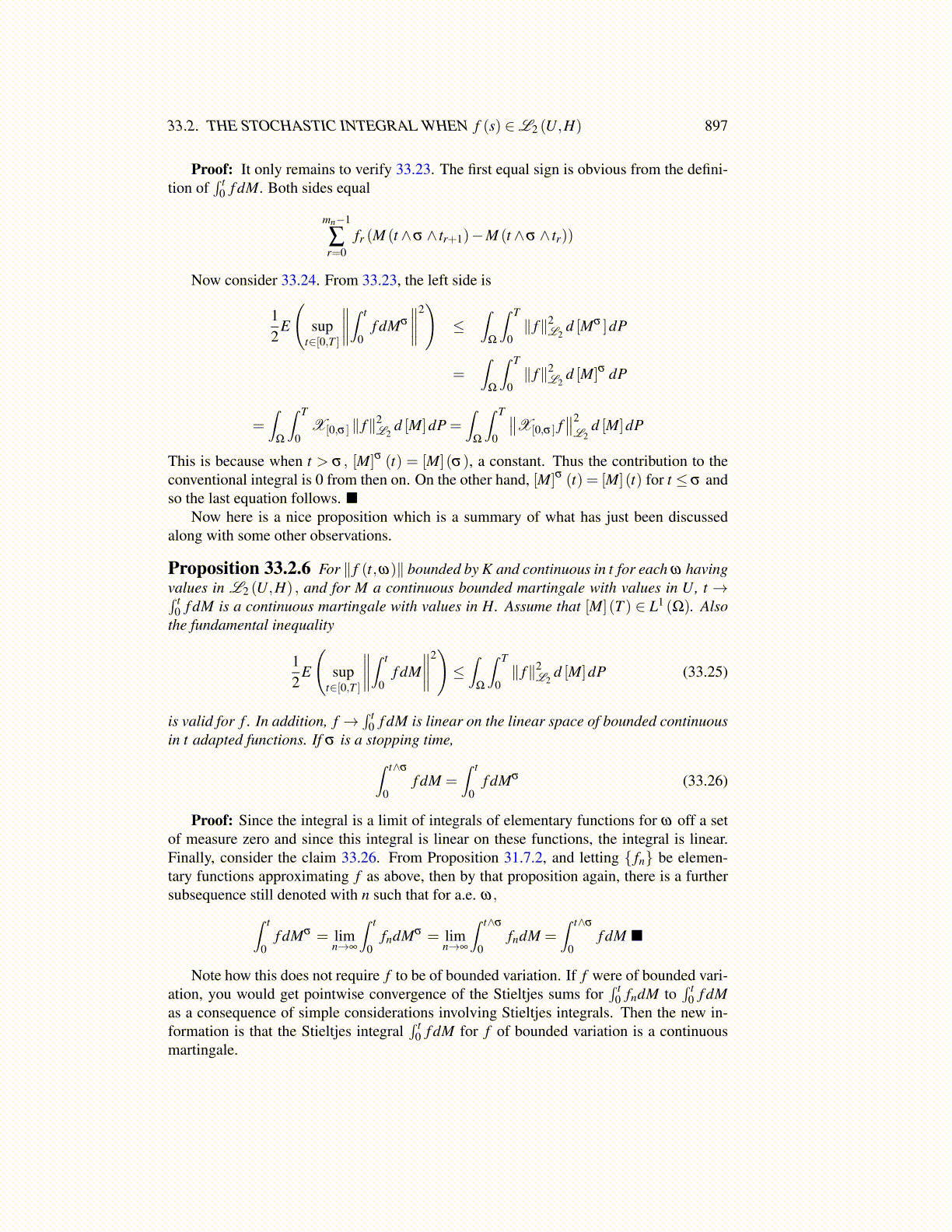
33.2. THE STOCHASTIC INTEGRAL WHEN f (s) ∈L2 (U,H) 897
Proof: It only remains to verify 33.23. The first equal sign is obvious from the defini-tion of
∫ t0 f dM. Both sides equal
mn−1
∑r=0
fr (M (t ∧σ ∧ tr+1)−M (t ∧σ ∧ tr))
Now consider 33.24. From 33.23, the left side is
12
E
(sup
t∈[0,T ]
∥∥∥∥∫ t
0f dMσ
∥∥∥∥2)≤
∫Ω
∫ T
0∥ f∥2
L2d [Mσ ]dP
=∫
Ω
∫ T
0∥ f∥2
L2d [M]σ dP
=∫
Ω
∫ T
0X[0,σ ] ∥ f∥2
L2d [M]dP =
∫Ω
∫ T
0
∥∥X[0,σ ] f∥∥2
L2d [M]dP
This is because when t > σ , [M]σ (t) = [M] (σ), a constant. Thus the contribution to theconventional integral is 0 from then on. On the other hand, [M]σ (t) = [M] (t) for t ≤ σ andso the last equation follows. ■
Now here is a nice proposition which is a summary of what has just been discussedalong with some other observations.
Proposition 33.2.6 For ∥ f (t,ω)∥ bounded by K and continuous in t for each ω havingvalues in L2 (U,H) , and for M a continuous bounded martingale with values in U, t →∫ t
0 f dM is a continuous martingale with values in H. Assume that [M] (T ) ∈ L1 (Ω). Alsothe fundamental inequality
12
E
(sup
t∈[0,T ]
∥∥∥∥∫ t
0f dM
∥∥∥∥2)≤∫
Ω
∫ T
0∥ f∥2
L2d [M]dP (33.25)
is valid for f . In addition, f →∫ t
0 f dM is linear on the linear space of bounded continuousin t adapted functions. If σ is a stopping time,∫ t∧σ
0f dM =
∫ t
0f dMσ (33.26)
Proof: Since the integral is a limit of integrals of elementary functions for ω off a setof measure zero and since this integral is linear on these functions, the integral is linear.Finally, consider the claim 33.26. From Proposition 31.7.2, and letting { fn} be elemen-tary functions approximating f as above, then by that proposition again, there is a furthersubsequence still denoted with n such that for a.e. ω,∫ t
0f dMσ = lim
n→∞
∫ t
0fndMσ = lim
n→∞
∫ t∧σ
0fndM =
∫ t∧σ
0f dM ■
Note how this does not require f to be of bounded variation. If f were of bounded vari-ation, you would get pointwise convergence of the Stieltjes sums for
∫ t0 fndM to
∫ t0 f dM
as a consequence of simple considerations involving Stieltjes integrals. Then the new in-formation is that the Stieltjes integral
∫ t0 f dM for f of bounded variation is a continuous
martingale.